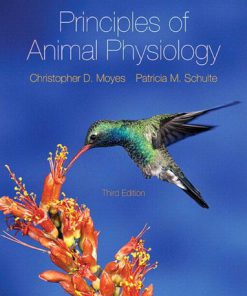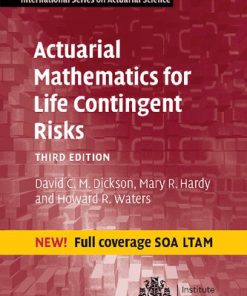Principles of Life 3rd Edition by David M Hillis, Mary V Price, Richard W Hill, David W Hall, Marta J Laskowski ISBN 9781319017712 1319017711
$50.00 Original price was: $50.00.$25.00Current price is: $25.00.
Principles of Life 3rd Edition by David M Hillis, Mary V Price, Richard W Hill, David W Hall, Marta J Laskowski – Ebook PDF Instant Download/Delivery: 9781319017712 ,1319017711
Full download Principles of Life 3rd Edition after payment

Product details:
ISBN 10: 1319017711
ISBN 13: 9781319017712
Author: David M Hillis, Mary V Price, Richard W Hill, David W Hall, Marta J Laskowski
Principles of Life 3rd Edition Table of contents:
Chapter 1 Principles of Life
1.1 Living Organisms Share Common Aspects of Structure, Function, and Energy Flow
Life as we know it had a single origin
Major steps in the history of life are compatible with known physical and chemical processes
Biologists can trace the evolutionary tree of life
Life’s unity allows discoveries in biology to be generalized
1.2 Life Depends on Organization and Energy
Organization is apparent in a hierarchy of levels, from molecules to ecosystems
Each level of biological organization consists of systems
Biological systems are highly dynamic even as they maintain their essential organization
Positive and negative feedback are common in biological systems
Systems analysis is a conceptual tool for understanding all levels of organization
1.3 Genetic Systems Control the Flow, Exchange, Storage, and Use of Information
Genomes encode the proteins that govern an organism’s structure
Genomes provide insights into all aspects of an organism’s biology
1.4 Evolution Explains the Diversity as Well as the Unity of Life
Natural selection is an important process of evolution
Evolution is a fact, as well as the basis for broader theory
1.5 Science Is Based on Quantitative Observations, Experiments, and Reasoning
Observing and quantifying are important skills
Scientific methods combine observation, experimentation, and logic
Getting from questions to answers
Well-designed experiments have the potential to falsify hypotheses
Statistical methods are essential scientific tools
Not all forms of inquiry into nature are scientific
Science informs society
This book is organized into the major themes of biology
Part 1 Cells
Chapter 2 Life’s Chemistry and the Importance of Water
2.1 An Element’s Atomic Structure Determines Its Properties
Atoms are composed of protons, neutrons, and electrons
Isotopes differ in the number of neutrons in the nucleus
Electrons occur in atomic orbitals in electron shells
Electrons in the outermost shell determine an element’s chemical properties
Some elements and isotopes are unstable
2.2 Atoms Bond to Form Molecules
Atoms share electrons in covalent bonds
Ionic bonds form between atoms by a transfer of electrons
Polar molecules can interact through electrostatic attractions
Molecules can weakly attract one another through van der Waals interactions
2.3 Chemical Transformations Involve Energy and Energy Transfers
Change in living systems involves energy transformations
The first law of thermodynamics states that energy cannot be created or destroyed
The second law of thermodynamics states that with each energy transformation, entropy increases
2.4 Chemical Reactions Transform Substances
Chemical reactions release or require energy
Not all chemical reactions begin spontaneously
Several factors affect the rate of a reaction
2.5 The Properties of Water Are Critical to the Chemistry of Life
High specific heat and high heat of vaporization enable water to moderate the temperature inside living systems
Hydrogen bonding accounts for the cohesion and adhesion of water
Water is a solvent for charged and polar substances
Aqueous solutions may be acidic, basic, or neutral
2.6 Functional Groups Give Molecules Specific Properties
Chemical characteristics of organic molecules depend on functional groups
Isomers contribute to molecular diversity
2 Visual Summary
Chapter 3 Macromolecules
3.1 Lipids Are Characterized by Their Insolubility in Water
Lipids are structurally and functionally diverse
Energy is stored in fats and oils
Phospholipids form biological membranes
Lipids have many other functions
3.2 Carbohydrates Are Made from Simple Sugars
Monosaccharides and disaccharides are simple carbohydrates
Oligosaccharides are carbohydrates composed of a few monosaccharides
Polysaccharides are composed of many monosaccharides
3.3 Nucleic Acids Are Informational Macromolecules
Nucleotides are the building blocks of nucleic acids
Base pairing occurs in both DNA and RNA
DNA carries information and is expressed through RNA
3.4 Proteins Are Polymers with Variable Structures
Amino acids are the building blocks of proteins
Amino acids are linked together by peptide bonds
Higher-level protein structure is determined by primary structure
Protein structure can change depending on the environment
3.5 The Function of a Protein Is Determined by Its Structure
A protein’s function is determined by its binding characteristics
Enzymes speed up biochemical reactions
Enzymes bind specific reactants at their active sites
Enzyme activities can be regulated
3 Visual Summary
Chapter 4 Cell Structure and Membranes
4.1 The Cell Membrane Separates the Interior of the Cell from Its Environment
Lipids form the hydrophobic core of the membrane
Proteins give a membrane special properties
Cell membrane carbohydrates are recognition sites
4.2 Passive and Active Transport Are Used by Small Molecules to Cross Membranes
Simple diffusion takes place through the phospholipid bilayer
Osmosis is the movement of water across membranes
Membrane permeability is increased by membrane proteins
Active transport moves solutes against their concentration gradients
Active transport systems are distinguished by their source of energy
4.3 Vesicles Are Used to Transport Large Molecules across Membranes in Eukaryotes
Exocytosis moves materials out of the cell
Endocytosis moves materials into the cell
4.4 Cell Size, Shape, and Ability to Move Are Determined by Internal and External Structures
Small cells have a high surface area-to-volume ratio
Several kinds of protein filaments are present in cells
Microfilaments determine cell shape and function in cell movement
Intermediate filaments are diverse and stable
Microtubules are the thickest elements of the cytoskeleton
Cell walls provide support and protection
The extracellular matrix supports various functions
Cell junctions connect adjacent cells
4.5 Compartmentalization Occurs in Prokaryotic Cells and Is Extensive in Eukaryotic Cells
Prokaryotic cells generally lack membrane-enclosed compartments within their cells
Eukaryotic cells possess numerous kinds of membrane-enclosed compartments
The nucleus contains most of the cell’s DNA
The endomembrane system is a group of interrelated organelles
Some organelles transform energy
Several other membrane-enclosed organelles perform specialized functions
4 Visual Summary
Chapter 5 Cell Metabolism: Synthesis and Degradation of Biological Molecules
5.1 ATP and Reduced Coenzymes Are the Energy Currency for Biosynthesis
ATP hydrolysis releases energy
Redox reactions transfer electrons and energy
5.2 Carbohydrate Catabolism in the Presence of Oxygen Releases a Large Amount of Energy
In glycolysis, glucose is partially oxidized and some energy is released
Pyruvate oxidation links glycolysis and the citric acid cycle
The citric acid cycle completes the oxidation of glucose to CO2
Energy is transferred from NADH to ATP by oxidative phosphorylation
Chemiosmosis uses the proton gradient to generate ATP
The proton gradient can also be used to produce heat
Oxidative phosphorylation and chemiosmosis yield a large amount of ATP
Respiration is regulated
Fermentation of glucose releases a small amount of energy
5.3 Catabolic Pathways for Carbohydrates, Lipids, and Proteins Are Interconnected
5.4 Anabolic Pathways Use Large Amounts of ATP
Anabolism can generate macromolecules and their subunits
Catabolism and anabolism are integrated into a system
5.5 Life Is Supported by the Sun: Light Energy Captured during Photosynthesis Converts Carbon Dioxide to Carbohydrates
Light energy is absorbed by chlorophyll and other pigments
Light absorption results in reduction of electron acceptors by chlorophyll a in the reaction center
Reduction leads to ATP and NADPH formation
The chemical-bond energy generated by the light reactions is used to convert CO2 to carbohydrates
Rubisco can use O2 instead of CO2 as a substrate
5 Visual Summary
Chapter 6 Cell Signals and Responses
6.1 Cells Detect a Variety of Signals
Organisms are able to detect environmental variables
Response to a signal occurs in three steps
Cells are exposed to many cell signals but respond to only a subset of them
6.2 Signal Molecule Receptors Can Be Classified into Several Groups
Receptors may be on the cell membrane or inside the cell
Classification of membrane receptors is based on their actions
6.3 Signal Transduction Allows a Cell to Respond Appropriately to a Signal
Cell functions change in response to environmental signals
A signaling cascade can involve enzyme regulation and signal amplification
Second messengers can stimulate signal transduction
6.4 Signal Transduction Is Highly Regulated
Signal pathways are actively reset
Signaling pathways integrate multiple signals
Misregulation of signaling is involved in a variety of health disorders
6 Visual Summary
Part 2 Genetics
Chapter 7 The Cell Cycle and Cell Division
7.1 Reproduction May Be Asexual or Sexual
Asexual reproduction by binary fission or mitosis results in genetic constancy
Sexual reproduction by meiosis results in genetic diversity
Sexual life cycles are diverse
7.2 Asexual Reproduction Results in Genetically Identical Daughter Cells
Prokaryotic cells divide by binary fission
Eukaryotic cells divide by mitosis followed by cytokinesis
Eukaryotic chromosomes are compacted into chromatin
Mitosis results in the production of genetically identical daughter nuclei
Cytokinesis is the division of the cytoplasm
7.3 Sexual Reproduction by Meiosis Halves the Number of Chromosomes and Generates Genetic Diversity
Meiosis halves the number of chromosomes
Independent assortment and crossing over generate diversity
7.4 Errors during Cell Division Can Result in Changes in Chromosome Number
Errors in mitosis and meiosis can result in abnormal numbers of some chromosomes
Errors in cytokinesis or fertilization can affect all chromosomes
7.5 The Cell Cycle and Cell Death Are Highly Regulated in Eukaryotes
Progression through binary fission is regulated in prokaryotes
Cell cycle regulation differs in eukaryotes and prokaryotes
The eukaryotic cell cycle is regulated internally
The eukaryotic cell cycle is controlled by cyclin-dependent kinases
Programmed cell death is a necessary process in living organisms
Cell division regulation is abnormal in cancer cells
7 Visual Summary
Chapter 8 Inheritance, Genes, and Chromosomes
8.1 Mendel Discovered Two Laws of Inheritance
Mendel used the scientific method to test his hypotheses
Mendel’s first experiments involved monohybrid crosses
Mendel’s first law states that allele pairs segregate equally into gametes
Mendel tested his hypotheses by performing test crosses
Probability is used to predict inheritance
Mendel’s second law states that allele pairs of different genes assort independently
Mendel’s laws can be observed in human pedigrees
8.2 Genes Are Inherited on Chromosomes
The behavior of chromosomes during meiosis is consistent with Mendel’s laws
Alleles encode different versions of the same protein
Sex-linked inheritance is consistent with sex chromosome transmission
Genes on the same chromosome can be separated by crossing over in meiosis
8.3 Alleles, Genes, and the Environment Interact to Produce Phenotype
A single gene can have multiple alleles
Dominance is not always complete
One gene can affect multiple characters, and one character can be affected by multiple genes
Some phenotypes are continuous
The environment affects gene action
8.4 Conjugation and Transformation Allow Exchange of Genetic Material between Prokaryotes
Bacteria transfer plasmid genes by conjugation
The evolution of drug-resistant bacteria is a major public health problem
Bacteria exchange chromosomal genes by conjugation
Some bacteria recombine with DNA taken up from their environment
8 Visual Summary
Chapter 9 DNA and Its Role in Heredity
9.1 DNA Is the Molecule of Inheritance
Circumstantial evidence suggested that DNA is the genetic material
Experimental evidence confirmed that DNA is the genetic material
Several types of information led to the discovery of the structure of DNA
Watson and Crick described the structure of DNA using chemical models
The double-helical structure of DNA is essential to its function
9.2 DNA Replication Is Semiconservative
DNA replicates semiconservatively
DNA replication involves several proteins
Telomeres are not fully replicated in eukaryotic cells
9.3 DNA Mutations Alter DNA Sequence
A common source of mutations is replication errors
Chemical changes in bases can lead to DNA mutations
Mutations can have various phenotypic effects
Chromosomal mutations are extensive changes in the genetic material
9 Visual Summary
Chapter 10 From DNA to Protein: Gene Expression
10.1 One Gene Encodes One Polypeptide
Observations in humans led to the proposal that genes encode enzymes
The concept of the gene has changed over time
Genes are expressed via transcription and translation
10.2 Gene Expression Begins with Transcription of DNA into RNA
RNA polymerases share common features
Transcription occurs in three steps
Eukaryotic coding regions are often interrupted by introns
Eukaryotic gene transcripts are processed before translation
10.3 The Rules for Translation of RNA into Amino Acids Are Contained in the Genetic Code
The information for protein synthesis lies in the genetic code
The genetic code predicts the effects of point mutations
10.4 RNA Is Translated into Amino Acids by Ribosomes
Transfer RNAs carry specific amino acids and bind to specific codons
Each tRNA is specifically attached to an amino acid
Translation occurs at the ribosome
Translation takes place in three steps
Polysome formation increases the rate of protein synthesis
10.5 Proteins Are Sometimes Modified after Translation
Signal sequences in proteins direct them to their cellular destinations
Many proteins are modified during or after translation
10 Visual Summary
Chapter 11 Regulation of Gene Expression
11.1 The Regulation of Gene Expression Occurs at Multiple Levels
Regulating gene expression allows genetically identical cells to have different phenotypes
Regulation occurs at all possible steps of gene expression
Transcriptional regulation conserves energy
Genes are subject to positive and negative regulation
11.2 Prokaryotic Gene Regulation Occurs Primarily at the Level of Transcription
Transcription regulation in prokaryotes can involve different sigma factors
Operons are units of transcriptional regulation in prokaryotes
Operator–repressor interactions regulate transcription in the lac and trp operons
Viruses use gene regulation strategies to hijack host cells
11.3 Eukaryotic Transcription Is Regulated by General and Specific Transcription Factors
Transcription factors act at eukaryotic promoters
The expression of transcription factors underlies cell differentiation
Eukaryotic viruses can have complex life cycles
11.4 Transcription Can Be Regulated by Epigenetic Changes to DNA and Histones
Modification of histone proteins affects chromatin structure and transcription
DNA methylation affects transcription
Epigenetic changes can be induced by the environment
DNA methylation can result in genomic imprinting
Transgenerational epigenetic inheritance is possible in some but not all organisms
11.5 Eukaryotic Gene Expression Can Be Regulated after Transcription
Different mRNAs can be made from the same gene by alternative splicing
Stability of mRNA can be regulated
Translation of mRNA can be regulated
Protein stability can be regulated
11 Visual Summary
Chapter 12 Genomes
12.1 The -omics Era Has Revolutionized Biology
Sanger sequencing uses chain termination to sequence DNA
DNA sequencing is now inexpensive at the genome scale
Transcriptomics identifies expressed genes
Genome sequences yield several kinds of information
Phenotypes can be analyzed using proteomics and metabolomics
12.2 Prokaryotic Genomes Are Small, Compact, and Diverse
Prokaryotic genomes are streamlined and diverse
Metagenomics reveals the diversity of viruses and prokaryotic organisms
Some sequences of DNA can move about the genome
The genes that are essential for cellular life can be identified experimentally
12.3 Eukaryotic Genomes Are Large and Complex
Model organisms reveal many characteristics of eukaryotic genomes
Gene families are common in many eukaryotic species
Eukaryotic genomes contain many repetitive sequences
12.4 Human Genomics Has Facilitated Advances in Many Areas
The human genome sequence held some surprises
Human variation can be used to determine ancestry and disease risk
Personal genomics will soon be commonplace in medicine
12 Visual Summary
Part 3 Evolution
Chapter 13 Processes of Evolution
13.1 Evolution Is Both Factual and the Basis of Broader Theory
Since we can directly observe evolution, why do we speak of “evolutionary theory”?
Darwin and Wallace introduced the idea of evolution by natural selection
13.2 Mutation, Selection, Gene Flow, Genetic Drift, and Nonrandom Mating Result in Evolution
Mutation generates genetic variation
Selection acting on genetic variation leads to new phenotypes
Natural selection increases the frequency of beneficial mutations in populations
Gene flow may change allele frequencies
Genetic drift may cause large changes in small populations
Nonrandom mating can change genotype or allele frequencies
13.3 Evolution Can Be Measured by Changes in Allele Frequencies
A population’s genetic structure can be described by frequencies of alleles and genotypes
Evolution will occur unless certain restrictive conditions exist
Deviations from Hardy–Weinberg equilibrium show that evolution is occurring
13.4 Selection Can Be Stabilizing, Directional, or Disruptive
Stabilizing selection reduces variation in populations
Directional selection favors one extreme
Disruptive selection favors extremes over the mean
13.5 Selection Can Maintain Polymorphisms in Populations
Frequency-dependent selection maintains genetic variation within populations
Heterozygote advantage maintains polymorphic loci
Genetic variation within species is maintained in geographically distinct populations
13 Visual Summary
Chapter 14 Reconstructing and Using Phylogenies
14.1 All of Life Is Connected through Its Evolutionary History
Phylogenetic trees depict evolutionary relationships among lineages
Phylogenetic trees are the basis of comparative biology
Derived traits provide evidence of evolutionary relationships
14.2 Phylogeny Can Be Reconstructed from Traits of Organisms
Shared traits reflect common ancestry
Parsimony provides the simplest explanation for phylogenetic data
Phylogenies are reconstructed from many sources of data
Mathematical models expand the power of phylogenetic reconstruction
The accuracy of phylogenetic methods can be tested
14.3 Phylogeny Makes Biology Comparative and Predictive
Phylogenetic trees can be used to reconstruct past events
Phylogenies allow us to compare and contrast living organisms
Phylogenies can reveal convergent evolution
Ancestral states can be reconstructed
Molecular clocks help date evolutionary events
14.4 Phylogeny Is the Basis of Biological Classification
Linnaean classification is based on standard taxon ranks
Evolutionary history is the basis for modern biological classification
Several codes of biological nomenclature govern the use of scientific names
14 Visual Summary
People also search for Principles of Life 3rd Edition:
seven principles of life
stoic principles of life
successful principles of life
principles of life support ppt
principles of life science
Tags: David M Hillis, Mary V Price, Richard W Hill, David W Hall, Marta J Laskowski, Life
You may also like…
Chemistry - Analytical Chemistry
Biology and other natural sciences - Biology
Biology and other natural sciences - Zoology
Chemistry - Chemistry - General & Miscellaneous
Principles of General Chemistry Martin Silberberg 3rd Edition Principles Of General Chemistry
Technique - Heat
History & Research
The Psychology of Quality of Life: Wellbeing and Positive Mental Health 3rd Edition M. Joseph Sirgy
Biology and other natural sciences - Molecular
Lehninger Principles of Biochemistry 7th Edition Nelson David L Cox Michael M











